Lafayette’s Triumphal Tour: America, 1824-1825
Probably because he had been traumatized by seven years of exile, and also because of Mme de Lafayette’s poor health, Lafayette declined the position of governor of Louisiana that was offered to him by his friend Thomas Jefferson in 1803 and 1804. Twenty years later, after he was defeated in the 1824 French elections, the widowed general gratified his long held wish to revisit the United States.
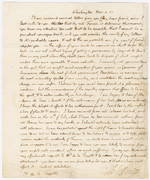 |
Thomas Jefferson. Letter to Lafayette. Washington, November 4, 1803. [zoom]
… In the affair of your lands be assured we shall do for the best. We are not without hopes of getting a permission by Congress to locate them in any part where they shall have lands to dispose of, which might render them more agreeable and more valuable. I sincerely wish you were here on the spot, that we might avail ourselves of your services as Governor of Louisiana, the seat of which government, New Orleans, is now among the most interesting spots of our country, and constitutes the most important charge we can confer. I believe too you would have found it a pleasant residence... I have received from Mr. Cabanis his book, and wrote him... Nothing of Mr. Tracy has come to my hands...
In 1804 the United States expressed its gratitude to Lafayette by granting him land in newly acquired “Louisiana”. On June 27, Jefferson insisted that “it would be a great satisfaction to see the Marquis of Lafayette a citizen of Louisiana”, and indicated that he might employ “fugitive Creoles from St. Domingo, used to the culture of sugar and cotton”. In fact the gift, like the Florida lands granted him in 1824, turned out to be a liability in that his attempts to sell portions of it to his creditors embroiled him in lawsuits. The letter also confirms the connection between Jefferson and French “Ideologues” such as Cabanis (Relations of the Physical and the Moral in Man, 1802) or Destutt de Tracy, George W. Lafayette’s father-in-law, who coined the term “ideology” and had his Commentaire sur l'Esprit des Lois de Montesquieu translated by Jefferson in 1811. |
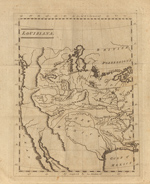 |
Map of Louisiana in Matthew Carey, American Pocket Atlas. Philadelphia, 1805. [zoom] |
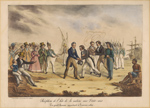 |
“A Great Man Belongs to the Whole Universe.” Hand Colored Lithograph, 1824. [zoom] With his son and his secretary, Levasseur, Lafayette boarded at Le Havre on July 12 and arrived in New York on August 15. His tour was a personal triumph. Lafayette’s itinerary took him throughout the East Coast, the Midwest, and the South, where he was uniformly welcomed and celebrated as a returning hero. In his memoirs, Walt Whitman would recall his excitement, as a child in Brooklyn, when Lafayette pressed him against his heart. Lafayette navigated the Hudson, the Mississippi and the Alabama on steamboats, and took a ride on balloon in New York; he received gifts ranging from swords to Indian artifacts to a black bear, which was sent to France and became the first of its kind to be displayed in a French zoo. |
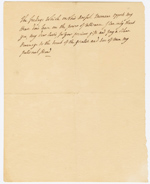 |
Lafayette. Words at the Tomb of Washington. [Mt. Vernon, October 17, 1824]. [zoom] | Additional images: 
“The feelings, which on this awful moment oppress my heart don’t leave me the power of utterance. I can only thank you, my dear Custis for your precious gift and pray a silent homage to the tomb of the greatest and best of men, my paternal friend.”
Lafayette thanks George Washington's adopted son, George Washington Parke Custis (1781-1857), for giving him a sprig of Cyprus plucked from the tomb of George Washington. An 1829 account by Auguste Levasseur, Lafayette’s personal secretary, describes Lafayette’s 1824 visit to Washington’s grave: “the tomb is scarcely perceived amid the somber cypresses... Lafayette descended alone in the vault, and a few minutes thereafter reappeared, with his eyes overflowing with tears. He took his son and me by the hand, and led us into the tomb... We knelt reverentially near his coffin, which we respectfully saluted with our lips; rising, we mingled our tears with his”. |
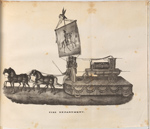 |
Fire truck “Lafayette”, in David Cadwallader: Memoir Prepared at the Request of a Committee of the Common Council of the City of New York… at the Celebration of the Completion of the New York Canals. New York, 1825. [zoom] In September 1824, New York City firemen expressed “the lasting gratitude of this Western World” to Lafayette by naming one of their fifteen hand-drawn pumps after him. |
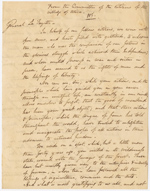 |
Citizens of Utica, New York. Letter of Congratulations to Lafayette, [1824]. [zoom] | View/download a PDF of this item
We reside on a spot which, built a little more than forty years ago, you visited in its wilderness state, covered with the Savages of the forest. These have but recently given way to the enterprise and industry of freemen, in whose train have followed all the blessings of agriculture, commerce and the arts... Such improvements can flow only from the energies of enlightened men...
A reader of Montaigne and Rousseau, Lafayette felt not contempt but paternalistic concern for the “Savages”. He had an Indian servant who called him “Father”; in 1825, he sympathized with Creek Chief William McIntosh and with Dr. Smith, a veteran of the Revolutionary War who drafted a constitution for the Seneca Nation. |
 |
Bank of the United States. Bank Draft to General Lafayette for 51,500 Francs. Philadelphia, September 28, 1827. [zoom] Lafayette, ruined by the two revolutions and by his continuous generosity, was not indifferent to money. He benefited equally from the reactionary decision taken in 1825 to indemnify the émigrés by a billion francs for the loss of their estates during the Revolution (approximately $1.5 million today), and from compensation granted to him by the United States Congress for his dedication during the Revolutionary War. In 1833, he sold his land near Tallahassee, Florida for the equivalent of about 4 million dollars. |
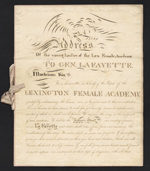 |
Address of the Young Ladies of the Lexington Female Academy to General Lafayette. [Lexington, Kentucky, 1825]. [zoom] Lafayette enjoyed an international female fan-club, a phenomenon highlighted during his 1824-25 tour of the United States. There were two reasons why the young ladies of the Lexington Academy felt a particular devotion to Lafayette: Lexington. a.k.a. “the Athens of the West,” was the capital of Fayette County, one of the original three counties formed in June 1780 from Virginia's Kentucky Territory. Lafayette was also known for his support of women’s education. This charming address was accompanied by pink ribbons, and by “a salutatory ode to Lafayette written at the request of her fellow pupils.” |